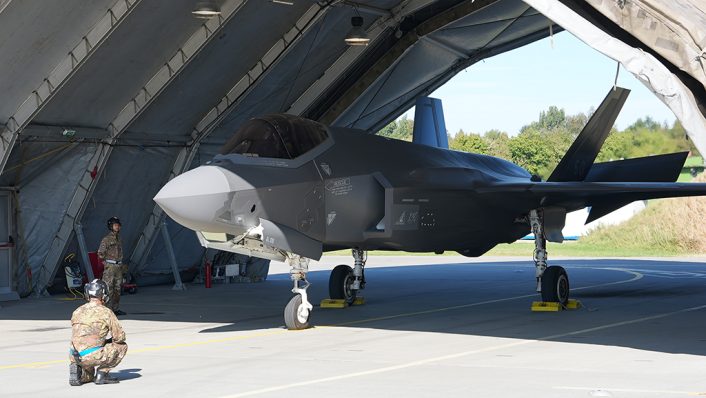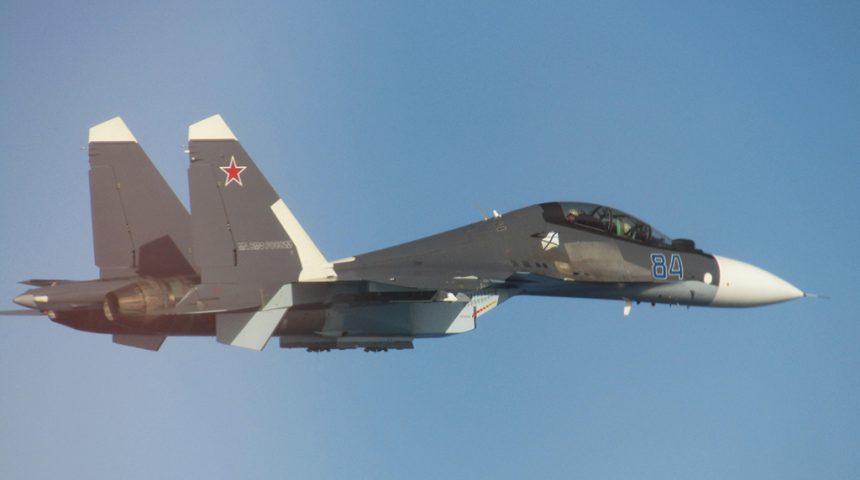We have obtained a photo of one of the two Su-30 Flankers intercepted by the Italian F-35 jets over the Baltic Sea last week.
On Sept. 21, 2023, two F-35A jets of the Italian Air Force Task Force Air – 32nd Wing, carried out the first QRA (Quick Reaction Alert) launch from Malbork Air Base, Poland, where the Italian Lightning II aircraft are currently deployed under NATO command to support the Baltic Air Policing mission.
The scramble was ordered by the Combined Air Operations Center (CAOC) based at Uedem in Germany, which is the NATO unit responsible for the monitoring of all radar tracks of suspicious aircraft approaching or attempting to enter protected NATO airspace.
The Italian F-35s were launched to investigate unknown aircraft flying in international airspace over the Baltic Sea without FPL (Flight Plan) and without being contact with the ATC (Air Traffic Control). The unknown aircraft turned out to be Russian Naval Aviation Su-30SM Flanker jets.

Initially, the Italian Air Force did not release any image of the intercepted Russian jets, but we have obtained a photo of one of the “zombies” (as unknown aircraft are nicknamed in interceptor pilots lingo) thanks to NATO Allied Air Command.
Interestingly, the Su-30 depicted in the image appears to be unarmed. Its bort number, 84 blue, makes the aircraft one of the most modern Su-30SM2 airframes assigned to the 4th Guards Naval Assault Aviation Regiment of the Baltic Fleet Aviation. Compared to the Su-30SM, the Su-30SM2 features upgraded avionics, ECM and radar control systems, as well as the ability to carry more weapons.
As per standard air policing procedures, the Italian F-35s shadowed the Russian Flankers, remaining in international airspace, until they approached Russian airspace (most probably near Kaliningrad Oblast).
The “Task Force Air – 32nd Wing”, operates F-35A aircraft belonging to the 32° Stormo (Wing) of Amendola and the 6th Wing of Ghedi. Its aim is to ensure the integrity and security of NATO airspace, “thus contributing to strengthening the defense and deterrence posture on NATO’s eastern flank.”
The Italian Air Force F-35s are not new to the air policing mission, having deployed to Iceland and Estonia multiple times since 2019. And the one on Sept. 21, 2023, is not the first time an Italian F-35 has a close encounter with a Russian Su-30SM. The first time the two types were involved in a close encounter was in 2021. Despite the intercept was pretty uneventful, the images of the two aircraft flying together were used one year later for some completely made up reports that changed the narrative, stating that the intercept had been carried out by the Russian aircraft on the Italian one, and that the F-35 pilot had been taken by surprise by the Su-30: a fake news that even included quotes of the pilot (even though no ItAF Lightning II pilot had ever been authorized to talk to the media…).
The Italian F-35s carry out the QRA service in Iceland with the same configuration used to support the domestic SSSA (Servizio Sorveglianza Spazio Aereo – Air Space Surveillance Service) on a rotational basis, where the SCL (Standard Conventional Load) includes two AIM-120C5 AMRAAM (Advanced Medium Range Air-to-Air Missile) missiles in the internal weapons bay. The Italian jets fly in this “lighter” configuration, compared to Norwegian ones, as they don’t have a short-range air-to-air missile, but this will change soon as AIM-9X Sidewinder AAMs (Air-to-Air Missiles) have been ordered.









